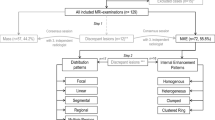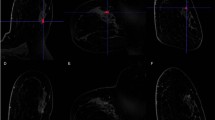Abstract
Objectives
To investigate whether kinetic features via magnetic resonance (MR)-computer-aided evaluation (CAE) can improve the positive predictive value (PPV) of morphological descriptors for suspicious lesions at screening breast MRI.
Methods
One hundred and sixteen consecutive, suspiciously enhancing lesions detected at contralateral breast MRI screening in 116 women with newly-diagnosed breast cancers were included. Morphological descriptors according to the revised BI-RADS Atlas and kinetic features from MR-CAE were analysed. The PPV of each descriptor was analysed to identify subgroups in which PPV could be improved by the addition of MR-CAE.
Results
When biopsy recommendations were downgraded to follow-up in cases where there were both the absence of enhancement at a 50 % threshold and the absence of delayed washout, PPV increased from 0.328 (95 % CI, 0.249-0.417) to 0.500 (95 % CI, 0.387- 0.613). Two ductal carcinoma in situ (DCIS) non-mass enhancement (NME) lesions were missed. Application of downgrading criteria to foci or masses led to increased PPV from 0.310 (95 % CI, 0.216-0.419) to 0.437 (95 % CI, 0.331-0.547) without missing cancers.
Conclusions
MR-CAE has the potential to improve the PPV of breast MR imaging by reducing the number of false positives. When suspicious mass lesions do not show enhancement at a 50 % threshold nor delayed washout, follow-up rather than biopsy can be considered.
Key Points
• MR-CAE has the potential to increase PPV at breast MRI screening.
•Lesions without enhancement at 50 % threshold and washout might be downgraded.
•DCIS non-mass lesions might be false-negative cases at MR-CAE.

Similar content being viewed by others
References
Kriege M, Brekelmans CT, Boetes C et al (2004) Efficacy of MRI and mammography for breast-cancer screening in women with a familial or genetic predisposition. N Engl J Med 351:427–437
Lehman CD, Isaacs C, Schnall MD et al (2007) Cancer yield of mammography, MR, and US in high-risk women: prospective multi-institution breast cancer screening study. Radiology 244:381–388
Kuhl CK (2007) Current status of breast MR imaging. Part 2. Clinical applications. Radiology 244:672–691
Kuhl CK, Schrading S, Leutner CC et al (2005) Mammography, breast ultrasound, and magnetic resonance imaging for surveillance of women at high familial risk for breast cancer. J Clin Oncol 23:8469–8476
Warner E, Plewes DB, Hill KA et al (2004) Surveillance of BRCA1 and BRCA2 mutation carriers with magnetic resonance imaging, ultrasound, mammography, and clinical breast examination. JAMA 292:1317–1325
Lehman CD, Blume JD, Weatherall P et al (2005) Screening women at high risk for breast cancer with mammography and magnetic resonance imaging. Cancer 103:1898–1905
Partridge SC, DeMartini WB, Kurland BF, Eby PR, White SW, Lehman CD (2009) Quantitative diffusion-weighted imaging as an adjunct to conventional breast MRI for improved positive predictive value. AJR Am J Roentgenol 193:1716–1722
Baltzer PA, Benndorf M, Dietzel M et al (2010) False-positive findings at contrast-enhanced breast MRI: a BI-RADS descriptor study. AJR Am J Roentgenol 194:1658–1663
Pinker K, Bickel H, Helbich TH et al (2013) Combined contrast-enhanced magnetic resonance and diffusion-weighted imaging reading adapted to the “Breast Imaging Reporting and Data system” for multiparametric 3-T imaging of breast lesions. Eur Radiol 23:1791–1802
Kul S, Cansu A, Alhan E, Dinc H, Gunes G, Reis A (2011) Contribution of diffusion-weighted imaging to dynamic contrast-enhanced MRI in the characterization of breast tumors. AJR Am J Roentgenol 196:210–217
Ei Khouli RH, Jacobs MA, Mezban SD et al (2010) Diffusion-weighted imaging improves the diagnostic accuracy of conventional 3.0-T breast MR imaging. Radiology 256:64–73
Lehman CD, Peacock S, DeMartini WB, Chen X (2006) A new automated software system to evaluate breast MR examinations: improved specificity without decreased sensitivity. AJR Am J Roentgenol 187:51–56
Williams TC, DeMartini WB, Partridge SC, Peacock S, Lehman CD (2007) Breast MR imaging: computer-aided evaluation program for discriminating benign from malignant lesions. Radiology 244:94–103
Wang LC, DeMartini WB, Partridge SC, Peacock S, Lehman CD (2009) MRI-detected suspicious breast lesions: predictive values of kinetic features measured by computer-aided evaluation. AJR Am J Roentgenol 193:826–831
Lehman CD, Blume JD, DeMartini WB, Hylton NM, Herman B, Schnall MD (2013) Accuracy and interpretation time of computer-aided detection among novice and experienced breast MRI readers. AJR Am J Roentgenol 200:W683–W689
Morris EA, Comstock CE, Lee CH et al (2013) ACR BI-RADS® Magnetic Resonance Imaging. In: ACR BI-RADS® Atlas, Breast Imaging and Reporting and Data System. American College of Radiology, Reston
Cho N, Kim SM, Park JS et al (2012) Contralateral lesions detected by preoperative MRI in patients with recently diagnosed breast cancer: application of MR CAD in differentiation of benign and malignant lesions. Eur J Radiol 81:1520–1526
American College of Radiology (2003) BI-RADS: MRI, 1st edn. In: Breast imaging reporting and data system: BI-RADS atlas. American College of Radiology, Reston
Comstock C, Sung JS (2013) BI-RADS 3 for magnetic resonance imaging. Magn Reson Imaging Clin N Am 21:561–570
Greenwood HI, Heller SL, Kim S, Sigmund EE, Shaylor SD, Moy L (2013) Ductal carcinoma in situ of the breasts: review of MR imaging features. Radiographics 33:1569–1588
Kim JA, Son EJ, Youk JH et al (2011) MRI findings of pure ductal carcinoma in situ: kinetic characteristics compared according to lesion type and histopathologic factors. AJR Am J Roentgenol 196:1450–1456
Mahoney MC, Gatsonis C, Hanna L, DeMartini WB, Lehman C (2012) Positive predictive value of BI-RADS MR imaging. Radiology 264:51–58
Gutierrez RL, DeMartini WB, Eby PR, Kurland BF, Peacock S, Lehman CD (2009) BI-RADS lesion characteristics predict likelihood of malignancy in breast MRI for masses but not for nonmasslike enhancement. AJR Am J Roentgenol 193:994–1000
Acknowledgements
The scientific guarantor of this publication is Nariya Cho. The authors of this manuscript declare no relationships with any companies, whose products or services may be related to the subject matter of the article. This research was supported by Basic Science Research Program through the National Research Foundation of Korea(NRF) funded by the Ministry of Education, Science and Technology(2012R1A1A1006722). No complex statistical methods were necessary for this paper. Institutional Review Board approval was obtained. Written informed consent was waived by the Institutional Review Board. Methodology: retrospective, diagnostic or prognostic study, performed at one institution.
Author information
Authors and Affiliations
Corresponding author
Rights and permissions
About this article
Cite this article
Gweon, H.M., Cho, N., Seo, M. et al. Computer-aided evaluation as an adjunct to revised BI-RADS Atlas: improvement in positive predictive value at screening breast MRI. Eur Radiol 24, 1800–1807 (2014). https://doi.org/10.1007/s00330-014-3166-1
Received:
Revised:
Accepted:
Published:
Issue Date:
DOI: https://doi.org/10.1007/s00330-014-3166-1




